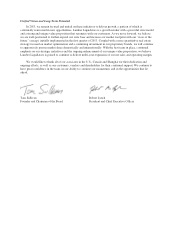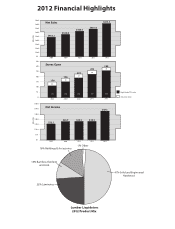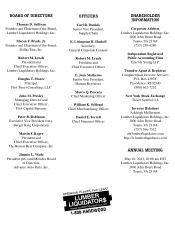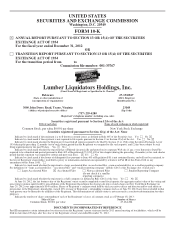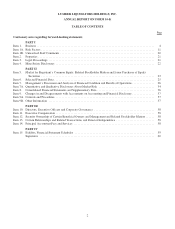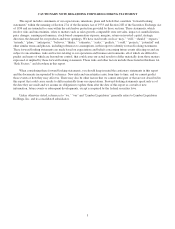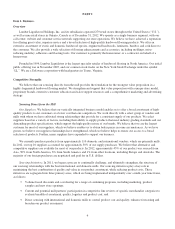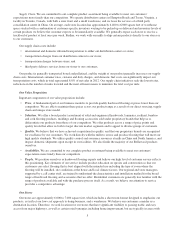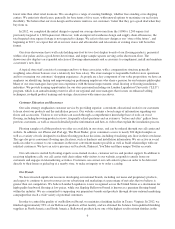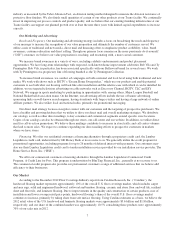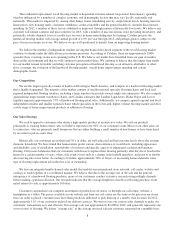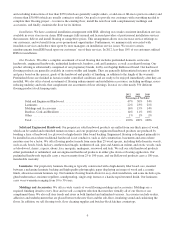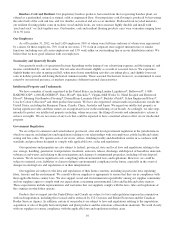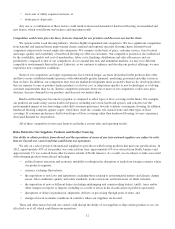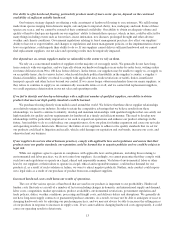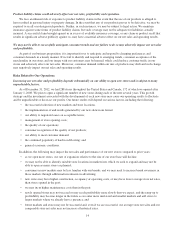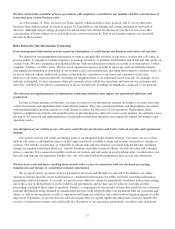Lumber Liquidators 2012 Annual Report Download - page 14
Download and view the complete annual report
Please find page 14 of the 2012 Lumber Liquidators annual report below. You can navigate through the pages in the report by either clicking on the pages listed below, or by using the keyword search tool below to find specific information within the annual report.The residential replacement wood flooring market is dependent on home-related, large-ticket discretionary spending,
which is influenced by a number of complex economic and demographic factors that may vary locally, regionally and
nationally. This market is impacted by, among other things, home remodeling activity, employment levels, housing turnover,
home prices, new housing starts, consumer confidence, credit availability and the general health of consumer discretionary
spending. In 2012, a number of these factors stabilized or improved, though remain at historically low levels. We believe our
customer will remain cautious and price sensitive in 2013, with a number of macroeconomic risks providing uncertainty, and
potentially volatile demand, even as a multi-year recovery in home remodeling may be forming. Catalina projects the
hardwood flooring market will average annual growth of 4.0% per year through 2015, and perhaps greater, subject to the
pace of macroeconomic recovery. We believe we are well-positioned to benefit from an improving housing market.
We believe the number of independent retailers serving the homeowner-based segment of the wood flooring market
continues to shrink under the difficult macroeconomic pressures. According to Catalina, there are approximately 9,000
specialty floor coverings stores now operating in the U.S. We believe our results have benefited from our gain of market
share in this environment and that we will continue to gain market share. We continue to believe that the longer term trends
for our market remain favorable, including customer perception of hardwood flooring as an attractive alternative to other
floor coverings, the evolution of the hardwood flooring market, overall home improvement spending and certain
demographic trends.
Our Competition
We are the largest specialty retailer of hardwood flooring in North America, and compete in a hardwood flooring market
that is highly fragmented. The majority of the market consists of smaller national specialty flooring chains and local and
regional independent flooring retailers, including a large number of privately-owned single-site enterprises. We also compete
against home improvement warehouse chains, and Catalina estimates that Lumber Liquidators, Home Depot and Lowes
together represent approximately 37% of hardwood flooring retail sales. Additionally, we compete against regional and local
independent retailers and smaller national chains which specialize in the lower-end, higher-volume flooring market and offer
a wide range of home improvement products in addition to flooring.
Our Sales Strategy
We seek to appeal to customers who desire a high-quality product at an attractive value. We sell our products
principally to existing homeowners, who we believe represent over 90% of our consumer count. Most of our other sales are
to contractors, who are primarily small businesses that are either building a small number of new homes or have been hired
by an owner to put in a new floor.
Historically, our customers are in their mid-30’s or older, are well-educated and have income levels above the average
domestic household. We have found that homeowners prefer various characteristics of wood floors, including appearance
and durability, ease of installation, renewability of resources and specific aspects of engineered, resilient and laminate
flooring. Our research indicates that our customers will choose to replace their flooring primarily after they have lived in the
home for a certain number of years, when a life event occurs such as a change in household members, and prior to or shortly
after moving into a new home. According to Catalina, approximately 28% of buyers of an existing home undertake some
type of flooring replacement job in the first year of ownership.
We have an integrated multi-channel sales model that enables our international store network, call center, website and
catalogs to work together in a coordinated manner. We believe that due to the average size of the sale and the general
infrequency of a hardwood flooring purchase, many of our customers conduct extensive research using multiple channels
before making a purchase decision. Our research indicates that the average length for a hardwood flooring purchase, from
initial interest to sale, is approximately 100 days.
Customers can purchase our complete assortment of products in our stores, or through our call center, website, a
smartphone or a tablet. The prices available on our website and from our call center are the same as the prices in our stores.
Once an order is placed, customers may have their purchases delivered or pick them up at a nearby store location. In 2012,
approximately 11% of our customers utilized our delivery services. We strive to use our various sales channels to make our
customers’ transactions easy and efficient. Our average sale was approximately $1,600 in 2012, and generally represents one
or two rooms of flooring. We define “average sale” as the average invoiced sale per customer, measured on a monthly basis
8


